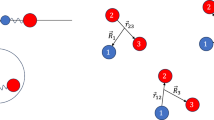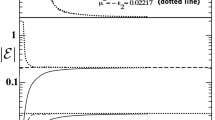Abstract.
We expose the relation between the properties of the three-body continuum states and their two-body subsystems. These properties refer to their bound and virtual states and resonances, all defined as poles of the S-matrix. For one infinitely heavy core and two non-interacting light particles, the complex energies of the three-body poles are the sum of the two two-body complex pole-energies. These generic relations are modified by center-of-mass effects which alone can produce a Borromean system. We show how the three-body states evolve in 6He, 6Li, and 6Be when the nucleon-nucleon interaction is continuously switched on. The schematic model is able to reproduce the main properties in their spectra. Realistic calculations for these nuclei are shown in detail for comparison. The implications of a core with non-zero spin are investigated and illustrated for 17Ne ( 15O + p + p). Dimensionless units allow predictions for systems of different scales.
Similar content being viewed by others
References
M.C. Gutzwiller, Rev. Mod. Phys. 70, 589 (1998).
G. Tanner, K. Richter, J.M. Rost, Rev. Mod. Phys. 72, 497 (2000).
A. Kievsky, M. Viviani, S. Rosati, Nucl. Phys. A 577, 511 (1994).
J.M. Richard, Phys. Rep. 212, 1 (1992).
L.D. Faddeev, Sov. Phys. JETP 12, 1014 (1961).
J. Carbonell, V.A. Karmanov, Phys. Rev. C 67, 037001 (2003).
E. Nielsen, D.V. Fedorov, A.S. Jensen, E. Garrido, Phys. Rep. 347, 373 (2001).
A.S. Jensen, K. Riisager, D.V. Fedorov, E. Garrido, Rev. Mod. Phys. 76, 215 (2004).
W. Glöckle H. Witala, D. Hüber, H. Kamada, J. Golak, Phys. Rep. 274, 107 (1996).
C.D. Lin, Phys. Rep. 257, 1 (1995).
T.N. Rescigno, M. Baertschy, W.A. Isaacs, C.W. McCurdy, Science 286, 2464 (1999).
E.O. Alt, S.B. Levin, S.L. Yakovlev, Phys. Rev. C 69, 034002 (2004).
A. Delfino, T. Frederico, M.S. Hussein, L. Tomio, Phys. Rev. C 61, 051301 (2000).
N.B. Shulgina, B.V. Danilin, L.V. Grigorenko, M.V. Zhukov, J.M. Bang, Phys. Rev. C 62, 014312 (2000).
T. Myo, K. Kato, S. Aoyama, K. Ikeda, Phys. Rev. C 63, 054313 (2001).
N. Michel, W. Nazarewicz, M. Ploszajczak, K. Bennaceur, Phys. Rev. Lett. 89, 042502 (2002).
R.Id. Betan, R.J. Liotta, N. Sandulescu, T. Vertse, Phys. Rev. C 67, 014322 (2003).
J. Jörres, M. Wiescher, F.-K. Thielemann, Phys. Rev. C 51, 392 (1995).
E. Garrido, D.V. Fedorov, A.S. Jensen, Nucl. Phys. A 695, 109 (2001).
E. Garrido, D.V. Fedorov, A.S. Jensen, H.O.U. Fynbo, Nucl. Phys. A 748, 39 (2005).
E.A. Kolganova, A.K. Motovilov, Y.K. Ho, Nucl. Phys. A 684, 623c (2001).
H. Witala, W. Glöckle, Phys. Rev. C 60, 024002 (1999).
Z. Papp, J. Darai, C.-Y. Hu, Z.T. Hlousek, B. Kónya, S.L. Yakovlev, Phys. Rev. A 65, 032725 (2002).
R. Lazauskas, J. Carbonell, Phys. Rev. C 70, 044002 (2004).
Y.K. Ho, Phys. Rep. 99, 1 (1983).
E. Garrido, D.V. Fedorov, A.S. Jensen, Phys. Rev. C. 68, 014002 (2003).
A. Csótó, Phys. Rev. C 49, 2244 (1994).
A. Csótó, Phys. Rev. C 49, 3035 (1994).
S. Aoyama, S. Mukai, K. Kato, K. Ikeda, Prog. Theor. Phys. 93, 99 (1995).
S. Aoyama, S. Mukai, K. Kato, K. Ikeda, Prog. Theor. Phys. 94, 343 (1995).
E. Garrido, D.V. Fedorov, A.S. Jensen, Phys. Lett. B 600, 208 (2004).
F. Ajzenberg-Selove, Nucl. Phys. A 490, 1 (1988).
E. Garrido, D.V. Fedorov, A.S. Jensen, Nucl. Phys. A 650, 247 (1999).
D.V. Fedorov, E. Garrido, A.S. Jensen, Few-Body Syst. 33, 153 (2003).
A. Cobis, A.S. Jensen, D.V. Fedorov, J. Phys. G 23, 401 (1997).
E. Garrido, D.V. Fedorov, A.S. Jensen, Phys. Rev. C 69, 024002 (2004).
E. Garrido, D.V. Fedorov, A.S. Jensen, Nucl. Phys. A 733, 85 (2004).
F. Ajzenberg-Selove, Nucl. Phys. A 460, 1 (1986).
B. Schwarzschild, Phys. Today 56, 19 (2003).
E. Nielsen, D.V. Fedorov, A.S. Jensen, J. Phys. B 31, 40855 (1998).
Author information
Authors and Affiliations
Corresponding author
Additional information
G. Orlandini
Rights and permissions
About this article
Cite this article
Garrido, E., Fedorov, D.V. & Jensen, A.S. Origin of three-body resonances. Eur. Phys. J. A 25, 365–378 (2005). https://doi.org/10.1140/epja/i2005-10130-3
Received:
Accepted:
Published:
Issue Date:
DOI: https://doi.org/10.1140/epja/i2005-10130-3




